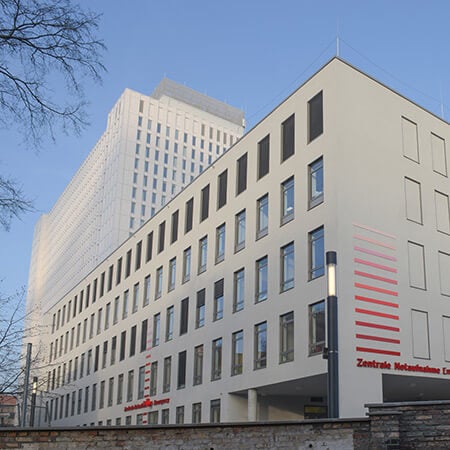Uterine prolapse is one of the most common gynecologic diseases in elderly patients. After age 50, pelvic organ prolapse occurs in more than half of all women. The early stages of the disease can be treated with conservative methods, but the advanced stages require surgery. You can undergo your diagnostics and treatment abroad to get rid of this problem once and for all. Healthcare facilities in developed countries offer minimally invasive operations with a short recovery period that provide reliable results. You are welcome to use the Booking Health service to find out the cost of treatment and choose a program for your diagnostics and treatment abroad at a favorable price.
Content
- Treatment principles
- Conservative treatment
- Uterus removal surgery
- Organ-preserving treatment
- Why to undergo your treatment abroad?
Treatment principles
The choice of a treatment option depends on a number of factors. These may be the following:
- severity of prolapse;
- prolapse of the uterus alone or combined with dropping out of other organs in the pelvic area;
- woman's age;
- requirements for maintaining the possibility of sexual activity;
- a desire to preserve the uterus;
- the presence of concomitant diseases;
- availability of technical and human resources for high-tech operations (laparoscopic or robot-assisted ones) at the hospital.
The goal of treatment for patients with the early stages of prolapse of the uterus is to relieve symptoms and stop the progression of the disease. A conservative tactic is usually used. Surgical techniques are used in the advanced stages and when a woman wants to solve her uterine prolapse problem once and for all without any permanent treatment.
Operations for pelvic organ prolapse are divided into the following two types:
- with removal of the uterus;
- with preservation of the uterus.
In turn, operations with the preservation of the uterus can be reconstructive or obliterative. Reconstructive ones are more commonly used as they restore the natural anatomy of the organs of the reproductive system. Obliterative operations involve suturing the vagina. These interventions make sexual life impossible, but they are less traumatic and suitable even for elderly patients weakened by concomitant diseases, for whom most surgical interventions are unsafe.
Conservative treatment
Patients with the early stages of uterine prolapse receive conservative treatment. It cannot cure the disease and is not even able to reduce the severity of the condition. Conservative therapy, however, can completely relieve a woman's symptoms and prevent the disease from progressing to the next stage.
The following mechanisms can be used to effect prolapse of the uterus with conservative methods:
- mechanical support of the organs;
- strengthening pelvic floor muscles;
- improvement of blood circulation in the pelvis;
- decrease in intra-abdominal pressure.
Gynecological pessaries are used for mechanical support of the organs in the pelvic area. These are devices that are inserted into the vagina. They keep the organs in the pelvic area in an anatomically correct position, eliminate most symptoms, and prevent the uterus from descending further. Patients have to wear pessaries all the time. After their removal, the symptoms will return.
Pessaries are selected individually. At the initial stage of treatment, it is sometimes necessary to change several pessaries to find the right one that does not move when bending over and urinating. Subsequently, the pessary should be changed at least once every 6-12 months. Some doctors insist on the need to replace it every 3-4 months to minimize the risk of complications. When using pessaries, it is necessary to undergo regular gynecological examinations. In the case of atrophic vaginitis, doctors prescribe an estrogen cream to relieve vaginal side effects. Every third woman experiences side effects from the use of gynecological pessaries, but they are usually not severe.
Additional methods of conservative treatment include the following:
Exercises to strengthen pelvic floor muscles allow women to withstand heavy loads from the abdominal cavity. A woman initially exercises under the guidance of an instructor, and after training, she can do it on her own. Exercises to strengthen pelvic floor muscles should be regular and continuous.
Physiotherapy helps improve the blood supply to the pelvic floor and has a symptomatic effect.
Lifestyle modification involves smoking cessation, normalizing body weight, and limiting physical activity to help patients lower their intra-abdominal pressure and improve blood flow to the pelvic tissues.
Treatment of chronic diseases may also be helpful, as some diseases cause chronically elevated intra-abdominal pressure, for example, constipation or bronchial asthma (due to coughing). Patients should receive adequate therapy. Women can often eliminate constipation without treatment by changing their lifestyle: increasing physical activity and increasing the amount of fiber and water in their diet.
Uterus removal surgery
A hysterectomy is considered a good treatment option for women with severe prolapse who are not interested in preserving their uterus. After uterus removal, prolapse of this organ is impossible, but prolapse of the vaginal fornix may occur. Therefore, doctors in developed countries, in addition to a hysterectomy, perform additional stages of surgery aimed at fixing the tissue and strengthening the ligaments.
A hysterectomy can be performed through different surgical approaches:
- vaginal;
- abdominal (through a large abdominal incision);
- laparoscopic (through short incisions using thin, long instruments under imaging guidance).
The choice of a surgical approach depends on the severity of prolapse and any concomitant pathologies of the uterus, the technical equipment at the hospital, and the availability of trained specialists who can perform high-tech operations. Doctors prefer a vaginal approach whenever possible. It is minimally traumatic and allows the specialists to repair prolapse not only of the uterus but also of other organs.
In addition to a hysterectomy, manipulations can be performed to prevent the prolapse recurrence (vaginal stump prolapse): fixing tissues to the uterosacral or sacrospinous ligaments and suturing to the sacrum with mesh implants.
Organ-preserving treatment
Most women want to preserve their uterus before they have menopause. Surgeons abroad perform minimally invasive and reliable organ-preserving operations that allow them to cure prolapse forever.
Hundreds of operations have been developed to treat uterine prolapse. Most are of only historical interest, but dozens of types of operations are still in use. The main manipulations that surgeons can do to eliminate prolapse are the following:
- shorten the ligaments to raise the prolapsed organs;
- suture the uterus to other tissues, for example, the anterior abdominal wall;
- strengthen the patient's own ligaments with synthetic tissues;
- strengthen ligaments with autologous (the patient's own) tissues, for example, rectus abdominis muscle aponeurosis flaps.
These operations are not performed through the vagina but through abdominal incisions using either open or laparoscopic techniques. The best medical centers abroad also offer robot-assisted operations. These surgical procedures are performed by a robotic surgical system controlled by a gynecologist. Such interventions are similar to laparoscopic ones, but they are safer.
In developed countries, a laparoscopic sacrocolpopexy is the most widely used among all operations. During the operation, doctors attach the uterus to the sacrum using a synthetic mesh. These interventions are preferred in women over 50 with a low risk of infectious complications (without diabetes mellitus, without immunodeficiency, etc.). They provide reliable results, and recurrences after such operations are very rare.
A laparoscopic sacrocolpopexy has the following advantages:
- high efficiency, which is at least 93% and, in specialized centers, up to 100%;
- the risk of uterine prolapse recurrence is 6% within 8 years of follow-up monitoring;
- maintaining the length of the vagina;
- preservation of the uterus;
- improving the quality of sexual life, both due to maintaining the length of the vagina and the absence of pain.
A colpocleisis is a good treatment option for women who do not intend to be sexually active. This is vaginal suturing surgery. It is minimally traumatic, reliable, and rarely causes any complications. Even in debilitated elderly patients with concurrent somatic diseases, the intervention can be performed safely. The disadvantage of vaginal suturing, in addition to the impossibility of sexual activity, is also the lack of access to the cervix and uterus. Some procedures for the diagnostics of diseases, such as pap tests of the cervix and an endometrial biopsy, become impossible.
Why to undergo your treatment abroad?
You can undergo your diagnostics and surgical treatment abroad to expect the best results. On the Booking Health website, you can find out the cost of treatment and choose a medical care program at a favorable price.
Uterine prolapse treatment abroad has the following advantages:
- high-precision diagnostics allows doctors to determine the severity and type of prolapse of the pelvic organs, as well as concomitant uterine diseases, and choose the best treatment option;
- specialists use minimally invasive operations, namely laparoscopic and robot-assisted ones;
- organ-preserving treatment without removal of the uterus is provided whenever possible;
- if the uterus is removed, the vaginal fornix is strengthened to avoid its prolapse in the future;
- the uterus is removed using minimally invasive surgical techniques, such as vaginal or laparoscopic surgery;
- single-stage treatment of prolapse of the uterus and other organs (rectum, urethra, bladder, or small intestine) can be provided;
- surgeons perform modern operations that ensure a low risk of recurrence and allow for a high quality of sexual life by preserving the normal length of the vagina.
If you have uterine prolapse, you are welcome to visit the Booking Health website to make an appointment for your diagnostics and treatment abroad. The best specialists in the world will take care of restoring your health. The cost of treatment for uterine prolapse will be low for you. The prices will be reduced due to the lack of additional coefficients for foreign patients. When you choose medical services through Booking Health, you will receive insurance against unforeseen medical expenses. The initial cost of treatment will therefore not increase after the start of your medical care program.
Authors:
The article was edited by medical experts, board-certified doctors Dr. Sergey Pashchenko and Dr. Vadim Zhiliuk. For the treatment of the conditions referred to in the article, you must consult a doctor; the information in the article is not intended for self-medication!
Sources:
WHO - World Health Organization
Verywell Health
MedicineNet




















